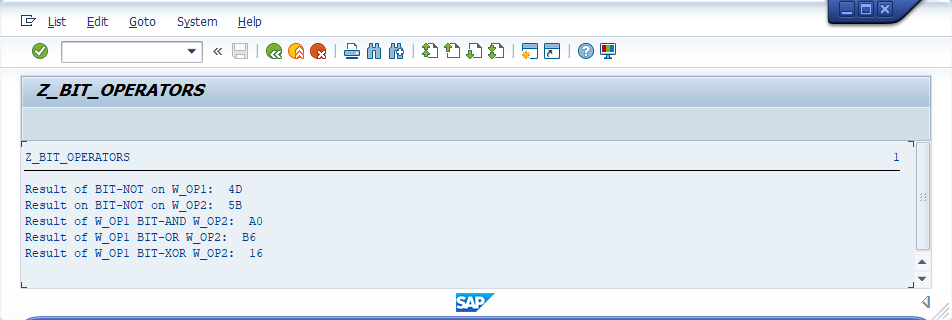SAP ABAP Bitwise Operators
The bit operators perform bit operations on two or more byte-like operands. ABAP supports a series of bit logical operators. Bit operators used to process Boolean algebraic expressions.
Bit expression formulates a binary calculation. Bit expressions are combined by using braces to formulate complex bit expressions.
Bit operators work on the individual bits of the operands. The bit operators BIT-AND, BIT-OR and BIT-XOR joins two adjacent operands.
The bit operator BIT-NOT negates a byte-like operand. BIT-NOT can be stated one or more times before an operand to negate the value of the operand. If BIT-NOT is specified an even number of times, the operand value remains unchanged. If BIT-NOT is specified an odd number of times, the operand value get changed.
Below table shows list of the arithmetic operators -
| Operator | Description | Priority |
|---|---|---|
| BIT-NOT | Unary operator performs NOT operation on bit by bit. BIT-NOT flips the bits in hexadecimal number to opposite value. | 1 |
| BIT-AND | Binary operator performs AND operation on bit by bit | 2 |
| BIT-XOR | Binary operator performs Exclusive OR operation on bit by bit | 3 |
| BIT-OR | Binary operator performs OR operation on bit by bit | 4 |
Below table describes how the BIT-AND, BIT-OR, BIT-XOR and BIT-NOT operations worked on individual bits.
| Operand1 | Operand2 | Operand1 BIT-AND Operand2 | Operand1 BIT-OR Operand2 | Operand1 BIT-XOR Operand2 | BIT-NOT Operand1 | BIT-NOT Operand2 |
|---|---|---|---|---|---|---|
| 0 | 0 | 0 | 0 | 0 | 1 | 1 |
| 0 | 1 | 0 | 1 | 1 | 1 | 0 |
| 1 | 0 | 0 | 1 | 1 | 0 | 1 |
| 1 | 1 | 1 | 1 | 0 | 0 | 0 |
Example -
Scenario - Below example shows how the bitwise operations coded in the program.
Code -
*&---------------------------------------------------------------------*
*& Report Z_BIT_OPERATORS
*&---------------------------------------------------------------------*
*& Written by TutorialsCampus
*&---------------------------------------------------------------------*
REPORT Z_BIT_OPERATORS.
* Declaring variables
DATA: W_OP1 TYPE X VALUE 'B2',
W_OP2 TYPE X VALUE 'A4',
W_NOT TYPE X,
W_AND TYPE X,
W_OR TYPE X,
W_XOR TYPE X.
* Applying BIT-NOT on W_OP1 and produces the result W_NOT.
W_NOT = BIT-NOT W_OP1.
WRITE: 'Result of BIT-NOT on W_OP1: ',W_NOT.
* Applying BIT-NOT on W_OP2 and produces the result W_NOT.
W_NOT = BIT-NOT W_OP2.
WRITE: /'Result on BIT-NOT on W_OP2: ',W_NOT.
* Applying BIT-AND on W_OP1, W_OP2 and produces the result W_AND.
W_AND = W_OP1 BIT-AND W_OP2.
WRITE: /'Result of W_OP1 BIT-AND W_OP2: ',W_AND.
* Applying BIT-OR on W_OP1, W_OP2 and produces the result W_OR.
W_OR = W_OP1 BIT-OR W_OP2.
WRITE: /'Result of W_OP1 BIT-OR W_OP2: ',W_OR.
* Applying BIT-XOR on W_OP1, W_OP2 and produces the result W_XOR.
W_XOR = W_OP1 BIT-XOR W_OP2.
WRITE: /'Result of W_OP1 BIT-XOR W_OP2: ',W_XOR.
Output -

Explaining Example -
In the above example, each and every statement is preceeded with a comment to explain about the statement. Go through them to get clear understanding of example code.
W_NOT = BIT-NOT W_OP1, applies BIT-NOT on W_OP1 and produces the result W_NOT. W_NOT = BIT-NOT W_OP2, applies BIT-NOT on W_OP2 and produces the result W_NOT.
W_AND = W_OP1 BIT-AND W_OP2, applies BIT-AND on W_OP1, W_OP2 and produces the result W_AND. W_OR = W_OP1 BIT-OR W_OP2, applies BIT-OR on W_OP1, W_OP2 and produces the result W_OR. W_XOR = W_OP1 BIT-XOR W_OP2, applies BIT-XOR on W_OP1, W_OP2 and produces the result W_XOR.
